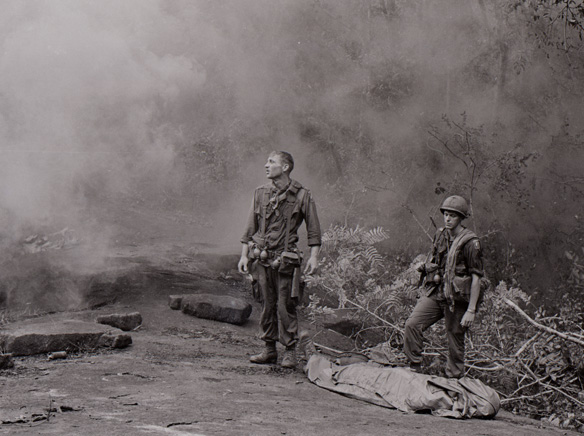Two years of the Vietnam War (1967 and 1968) accounted for nearly 49 percent of all Americans killed in action, with 11,363 in 1967 and 16,899 in 1968, according to the National Archives.
Two years of the Vietnam War (1967 and 1968) accounted for nearly 49 percent of all Americans killed in action, with 11,363 in 1967 and 16,899 in 1968, according to the National Archives.
Fifty years after the beginning of that zenith, a select group filled the Balboa Theater in downtown San Diego to view excerpts from the 18 hours of “The Vietnam War,” a film by renowned documentarians Ken Burns and Lynn Novick. While the lengthy line of folks waited at the entrance to the theater, it seemed like the scene was transported back to the 1960s as an anti-war activist and military supporter separately worked the line.
A gent from San Diego Veterans for Peace was asking individuals to choose not to attend the Marines’ Miramar Airshow, which the SDVFP website says “glorifies war with an exciting and colorful show of speed, power and noise; celebrates the skills and machinery that exist to kill, maim and destroy; misuses taxpayers’ money for entertainment and defense industry marketing and sales; is dangerous – 10 percent of Blue Angels pilots have been killed in accidents, Miramar jets have already crashed in San Diego neighborhoods; and serves as a misleading recruiting tool for our unsuspecting youth.” Not long after, an older lady walked the line, asking everyone if he/she was a veteran and had served in Vietnam. She then heartily shook the hand of each veteran, thanking and blessing them.
The war may have ended on April 30, 1975, but it is real and present today for many.
Even now, decades later, individuals who served in Vietnam are being recognized for their gallantry on its battlefields. For example, local Marine veteran Mike “Hooter” Van Houtte was presented the Bronze Star with Combat “V” on April 21 for his actions during Operation Union on April 21, 1967, 50 years ago to the day.
These awards ceremonies are important, even if not exactly timely, in no small way because of the way some treated the warriors returning from Southeast Asia, an unpopular war then, like the recent and current unpopular wars, a theme of sorts addressed by the film’s directors.
During introductory comments for this showing as part of the KPBS GI Film Series, Burns expressed hope the film will start a dialogue to “begin a conversation about something we haven’t wanted to talk about for a long while.” Reference was made to current discord about the recent wars going back to the time of the Vietnam War, with one excerpt offering, “The seeds of today are found in the Vietnam experience,” an experience explored by this film, which took 10 years to complete.
Over 53 minutes, the audience was taken from the French incursion into what was then Indo-China in 1858, to the Gulf of Tonkin incidents used to justify American intervention, to Con Tien in 1967 (“the last place on Earth you wanted to be if you were a Marine”), to Tet ’68, the return of our POWs, and the fall of Saigon.
At the end of the showing, Burns and Novick came on stage with KBPS military reporter Steve Walsh to offer additional commentary. Burns, perhaps surprisingly, said it is “impossible to ever get rid of war.” In response to a question from Walsh, Novick said they would not be judges of the war but would just tell the story.
Two of their comments received rousing applause. First, when Burns spoke of today’s military being “apart and alone from the rest of us” then advocating compulsory national service because it is not “healthy in the long term” to not have everyone serve the nation. Second, when Novick said the central lesson was to “never again not support the men and women we send to war.”
Unlike the global war on terrorism, there were no parades upon returning from the Vietnam War. No free meals. No one saying thank you for your service. As Marine Corps Vietnam combat veteran Frank Pedersen said, “We got nothing.”
The Vietnam veterans are remembered in a historically unique manner, one rich with pathos and meaning. Meaning that has increased over time. One thing is different now though. Our nation, by and large, does not blame the soldier, sailor, airman or Marine who fought in Iraq and/or Afghanistan. Perhaps fulfilling what Novick said is the nation’s nation need to “honor those who served and the families who sacrificed.”
Eventually the lack of self-identification as Vietnam veterans began to change, maybe as a byproduct of the Vietnam Veterans Memorial.
On Nov. 13, 1982, the Vietnam Veterans Memorial – aka The Wall – was dedicated in the nation’s capital. A powerful visual statement around which controversy initially swirled, it lists in chronological order of their deaths the Americans who died during the war. This year will be the 30th anniversary of Rolling Thunder, started by three Vietnam veterans at the initial event leading to about 2,500 motorcycles from across the nation gathering in Washington D.C. on Memorial Day 1988 seeking from the nation’s leaders a full accounting of all POW/MIA, a remaining cause with more than 1,600 unaccounted for from the Vietnam War. Over the years, Rolling Thunder has grown and in 2016 an estimated 250,000 motorcycles rumbled through the streets of the nation’s capital. The destination – The Wall – has become the defining symbol for that generation of warriors, spawning associated events such as the Run for the Wall motorcycle journey, initiated in 1989 by two other Vietnam Veterans. Starting in California with Rolling Thunder and The Wall as the destinations, Run for the Wall gives “Vietnam Veterans and all veterans the opportunity to receive their own ‘welcome home’ and start their healing process,” according to its website. For the Vietnam generation, The Wall is the symbol of their war, evoking decades old memories of what was and what was not.
Now it is more common for Vietnam veterans to self-identify as such. A period of anonymity replaced by personal acknowledgement, as experienced during watching the excerpts from “The Vietnam War.” A Marine Corps enlisted Vietnam veteran sat next to me. From time to time Charley would nudge me, offering a personal comment about a scene that just played, adding his personal oral history to what was shown and told by the film, acknowledging his role in the war. Perhaps this was, in a small way, part of a beginning of that conversation Burns hopes will start because of people watching the film.
Understandably proud of the film, Botstein described it as “an amazing journey with an incredible team of producers, associate producers, researchers, interns, editors and apprentice editors who spent years living and breathing it.” She echoed Burns’ comment saying, after people spend a “big chunk of their lives watching 18 hours” of the film, she is interested in a “new and thoughtful conversation about the war that our country hasn’t had.”
Will this film cause other viewers, particularly those who lived in the times, let alone those who lived in the war like Charley, to think of their own memories, to wrestle with them? Will it be cathartic for Vietnam veterans and the nation? Will it begin the conversation envisioned by directors Burns and Novick? Charley’s reaction to the evocative excerpts seems a positive indicator. The impact once all 18 hours are played will be seen. Will it be as Botstein asked, “The film raises questions about what it means to be a patriot and what is our civic duty? What is the responsibility of the nation to the people who fight its wars?” And will it be as Botstein also observed, “We don’t point arrows and make direct connections, but if you watch the whole film, it’s hard not to make a connection to our contemporary world. It’s not something we point our audience to. We let our audience find those connections on their own.”
And the “compelling visual,” as Botstein put it, was apparent. From what she described as thousands and thousands of hours of archival and news footage, the team selected the most compelling, though not at the expense of still photos, which Botstein states Burns feels are “the DNA of their films.”
Speaking of the power of still photographs and how we are drawn to them, Botstein mentioned some that could be considered iconic images from the war: the burning monk in the streets of Saigon, the suspected Viet Cong being shot by the police chief, the naked girl running down the roadway and the body on the ground at Kent State. To these examples some others might be added: the body of a Marine Corps lieutenant being carried in a poncho by his men, soldiers walking across the dike of a rice paddy, Huey helicopters in the air, released POW Lt. Col. Robert L. Stirm and family at their reunion, and the line of people climbing to the helicopter on the rooftop during the evacuation of Saigon in 1975. Indeed, many still photographs filled the screen during this viewing.
Interspersed with combat and media footage were comments from American veterans, Viet Cong and North Vietnamese Army combat veterans, their views providing historical context during the telling of the story by Burns and Novick. At some points, the views seemed very similar.
Overall, producer Sarah Botstein speaks of the film being structured chronologically, pretty much up to the current time. In the all too brief 53 minutes, the viewers were exposed to numerous other threads of what Burns repeatedly called a “very complex” story. For example, the impact and influence of the media back home, and the draft and its inequities, with a parallel situation in North Vietnam.
It is not the forgotten war. It is the unspoken war. Upon returning from Vietnam, veterans for the most part did not self-identify. For years, it was this way for these warriors. In an example played out on screen, a Marine veteran related that only after being neighbors and friends with another couple for 12 years did it come out that he and the other guy were both Marines who had fought in Vietnam. Not at all unusual, as the excerpt conveyed.
Years later the memorial’s designer, Maya Lin, stated, “I wanted to create a memorial that everyone would be able to respond to, regardless of whether one thought our country should or should not have participated in the war. The power of a name was very much with me at the time, partly because of the Memorial Rotunda at Yale. In Woolsey Hall, the walls are inscribed with the names of all the Yale alumni who have been killed in wars. I have never been able to resist touching the names cut into these marble walls and, no matter how busy or crowded the place is, a sense of quiet reverence always surrounds those names.” The power of the individual names, depiction of the human cost of war, and reverence created by the memorial led directly to a now iconic national Vietnam veteran event – Rolling Thunder.
Conversation. Catharsis. Connection. “The Vietnam War” certainly has the potential for being the genesis of all of these.
“The Vietnam War” will be broadcast beginning Sept. 17 on PBS.














